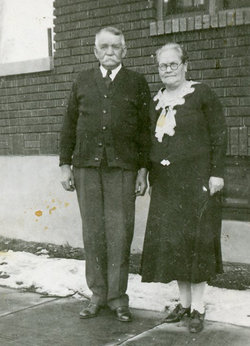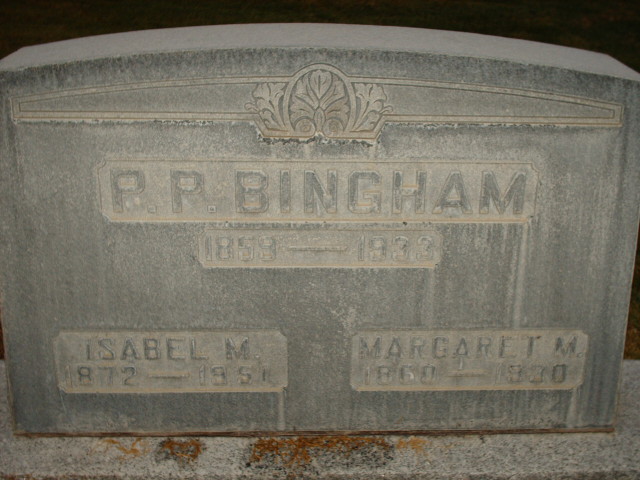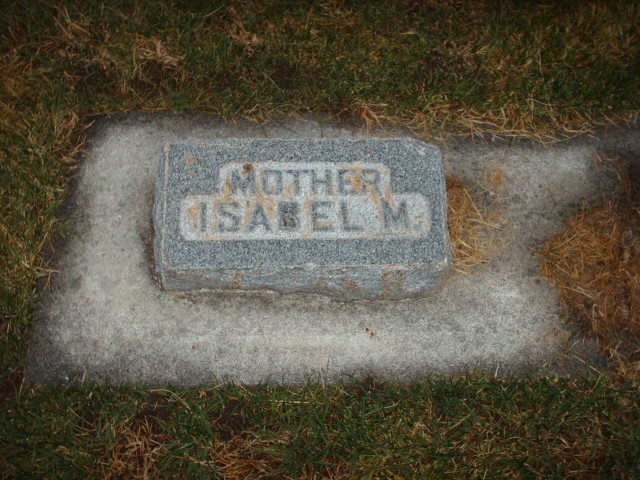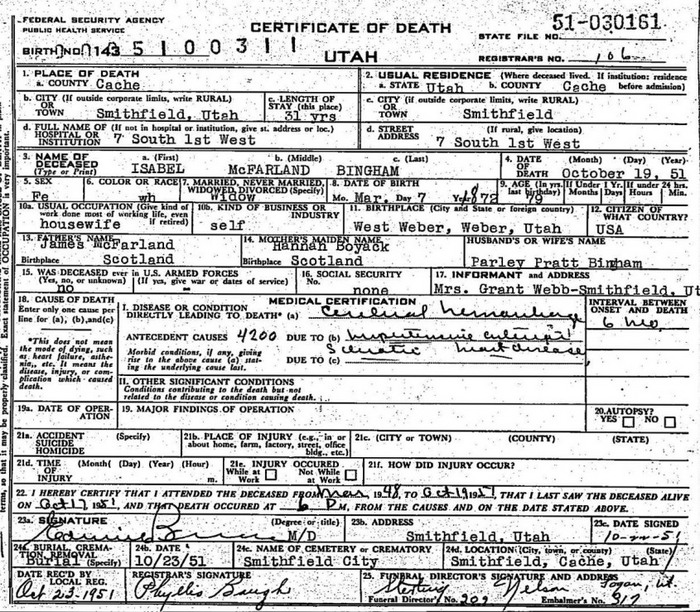At the age of eight she began tending children here and there helping her relatives in what she could and earning her living. At the age of seventeen she went into Ogden each day to learn the trade of dressmaking, riding with her brother-in-law, Ezra Bingham, in a two wheel cart pulled by one horse. The following four years she worked for a dressmaker, Mrs. Peterson. She received only a small salary, but was willing to work at any price in order to be able to support herself, helping her family and satisfying her independent spirit, which has been one of her admirable qualities throughout her life.
By constant attendance at Sunday School in Wilson Ward she was placed as second counselor to Mrs. Emma Wilcox in the Young Womens Mutual Improvement Association in Wilson Ward.
On 30 August 1893 at the age of twenty-one she received her endowments in the Salt Lake Temple in order that she might work for the dead. This line of work appealed to her throughout her life and she continued going as often as possible, thus doing work for hundreds. She told how as a primary child she used to save her few nickels in order to help build the Logan Temple. Later in her life at the age of 70, when her health would not permit her to do temple work as often as she liked, she tried to do her part by keeping a man and lady's temple suit on hand and ready, so anyone of her family or others could go and help further the great work.
When a very young lady she went to work for her sister and brother-in-law in order to have a place to stay and help. It was while working here that her husband-to-be, Parley, realized her wonderful qualities and sought her. Thus 15 April 1896 she married Parley Pratt Bingham in Mexico, by Apostle Teasdale, and sealed by the power of the Priesthood. She has said many times that she knew he was the one man for her and that if she couldn't have had him, she wouldn't have had any. They were about the last couple to be married under the law of polygamy.
The first home of their married life they made in Wilson Ward. It was here she gave birth to their first son and daughter, Percy and Leone. January 20, 1901, Isabel and her husband moved to Cache Valley and made their home in Trenton now called Amalga, for the purpose of helping build the West Cache Canal. It was mighty hard to leave all her friends and relatives and move to a sparsely populated farming district. It appeared to be the thing to do, so of course, she was willing to do anything to help. They moved into a small on room log house. Burning sagebrush was no easy task during the long cold winter months.
In 1902, one year later, they moved into their recently finished two story red brick house. They remained here for the following 18 years. During her lifetime she moved thirty times.
She was not only a good mother, but a good godmother as well. The kids used to say if you're hungry just go in and look around, and Aunt Bell will give you something.
The Amalga Ward was organized in 1918; and she was set apart as second counselor in the Relief Society, 24 March 1918, by Bishop Jesse L. Mortensen. At this time of her own choice she refrained from the use of tea and coffee and has never tasted it since.
Many good times were had in the small ward to help out the hardships. Parties and dances were held in their homes and the hotel which was built in the sugar factory string. As a source of recreation she used to take her children and neighbor (Suse) with her family on a buggy pulled by one horse (Dan) down to Bear River for a day of fishing. The children amused themselves while the two mothers fished and visited.
On 3 January 1920 she moved to Smithfield into a new white brick house they had just built. Four months later, at the age of 48, her last child was born making a total of ten children; Percy, Leone, Annetta, Wallace, Lawrence, Winona, Norman, Ralph, Erma and Eunice. Soon after moving into the Second Ward she was chosen as a Relief Society teacher; working in this position until the ward was divided.
She used to help stretch the family budget in more than one way. She was the family barber, even cutting her husband's hair. A time or two when he went to the barber, she had to trim it up a little better upon his return. She also used to trim wool from sheep pelts, wash and cord it into bats, and made many warm quilts. She was a very good cook. One of her sons-in-law said he had never tasted poor bread at her home. She always delighted in having something good to give her children when they happened in. One of her granddaughters, at age seven, said she wanted her to live so she could make her a wedding cake like the one she had just made for the first grandchild to be married.
She was set apart as a Primary teacher 7 December 1924 and taught a group of boys (Trailbuilders); watching their growth throughout her life, and being interested and pleased when they were sent on missions as young men. March 4, 1926, she was set apart as first counselor in the Relief Society by Bishop Geo. E. Kingsford. On 11 September, 1927, she was put in as President of the organization by the same bishop. It was while in this position that many people of the ward learned of her unselfish character and willingness to do her share which caused them to love her and later judge her children by her good qualities. She was released 8 January, 1933, on account of her husband's poor health because of lack of time for such a position, but was placed back in as a visiting teacher for five more years.
On 8 April, 1933, she was left a widow with two daughters; but her faith in God and her strong spirit of courage caused her to go on and do good for her family and friends. Very seldom was there ever any complaint heard from her. She kept her children and whomever she came in contact with from knowing her great sorrow.
One of her hobbies was quilt making. She made each of her daughters several lovely quilts for their trousseaus, and then tried to give a nine patch quilt (a favorite pattern) to one granddaughter out of each family. She also raised nine out of her 10 children to man and womanhood; seeing each begin their families and helped them start out.
She not only thought of the living, but of the dead as well. She placed a nice stone monument at the grave of her father in 1940, which she paid for herself. She said, "he had surely earned a marking to tell of his burial place". She never grew too old to like to surprise her children at Christmastime, remembering them with something they knew nothing about.
She spent the last three years of her life in poor health. In April 1951, she suffered from a stroke and a broken hip. She died on 19 October, 1951, at her home in Smithfield, Utah, at the age of 79.
"The Descendants of Erastus Bingham and Lucinda Gates" published by The Erastus Bingham Family Corp., Ogden, Utah, June 1977
bio prepared by Linda Owens
At the age of eight she began tending children here and there helping her relatives in what she could and earning her living. At the age of seventeen she went into Ogden each day to learn the trade of dressmaking, riding with her brother-in-law, Ezra Bingham, in a two wheel cart pulled by one horse. The following four years she worked for a dressmaker, Mrs. Peterson. She received only a small salary, but was willing to work at any price in order to be able to support herself, helping her family and satisfying her independent spirit, which has been one of her admirable qualities throughout her life.
By constant attendance at Sunday School in Wilson Ward she was placed as second counselor to Mrs. Emma Wilcox in the Young Womens Mutual Improvement Association in Wilson Ward.
On 30 August 1893 at the age of twenty-one she received her endowments in the Salt Lake Temple in order that she might work for the dead. This line of work appealed to her throughout her life and she continued going as often as possible, thus doing work for hundreds. She told how as a primary child she used to save her few nickels in order to help build the Logan Temple. Later in her life at the age of 70, when her health would not permit her to do temple work as often as she liked, she tried to do her part by keeping a man and lady's temple suit on hand and ready, so anyone of her family or others could go and help further the great work.
When a very young lady she went to work for her sister and brother-in-law in order to have a place to stay and help. It was while working here that her husband-to-be, Parley, realized her wonderful qualities and sought her. Thus 15 April 1896 she married Parley Pratt Bingham in Mexico, by Apostle Teasdale, and sealed by the power of the Priesthood. She has said many times that she knew he was the one man for her and that if she couldn't have had him, she wouldn't have had any. They were about the last couple to be married under the law of polygamy.
The first home of their married life they made in Wilson Ward. It was here she gave birth to their first son and daughter, Percy and Leone. January 20, 1901, Isabel and her husband moved to Cache Valley and made their home in Trenton now called Amalga, for the purpose of helping build the West Cache Canal. It was mighty hard to leave all her friends and relatives and move to a sparsely populated farming district. It appeared to be the thing to do, so of course, she was willing to do anything to help. They moved into a small on room log house. Burning sagebrush was no easy task during the long cold winter months.
In 1902, one year later, they moved into their recently finished two story red brick house. They remained here for the following 18 years. During her lifetime she moved thirty times.
She was not only a good mother, but a good godmother as well. The kids used to say if you're hungry just go in and look around, and Aunt Bell will give you something.
The Amalga Ward was organized in 1918; and she was set apart as second counselor in the Relief Society, 24 March 1918, by Bishop Jesse L. Mortensen. At this time of her own choice she refrained from the use of tea and coffee and has never tasted it since.
Many good times were had in the small ward to help out the hardships. Parties and dances were held in their homes and the hotel which was built in the sugar factory string. As a source of recreation she used to take her children and neighbor (Suse) with her family on a buggy pulled by one horse (Dan) down to Bear River for a day of fishing. The children amused themselves while the two mothers fished and visited.
On 3 January 1920 she moved to Smithfield into a new white brick house they had just built. Four months later, at the age of 48, her last child was born making a total of ten children; Percy, Leone, Annetta, Wallace, Lawrence, Winona, Norman, Ralph, Erma and Eunice. Soon after moving into the Second Ward she was chosen as a Relief Society teacher; working in this position until the ward was divided.
She used to help stretch the family budget in more than one way. She was the family barber, even cutting her husband's hair. A time or two when he went to the barber, she had to trim it up a little better upon his return. She also used to trim wool from sheep pelts, wash and cord it into bats, and made many warm quilts. She was a very good cook. One of her sons-in-law said he had never tasted poor bread at her home. She always delighted in having something good to give her children when they happened in. One of her granddaughters, at age seven, said she wanted her to live so she could make her a wedding cake like the one she had just made for the first grandchild to be married.
She was set apart as a Primary teacher 7 December 1924 and taught a group of boys (Trailbuilders); watching their growth throughout her life, and being interested and pleased when they were sent on missions as young men. March 4, 1926, she was set apart as first counselor in the Relief Society by Bishop Geo. E. Kingsford. On 11 September, 1927, she was put in as President of the organization by the same bishop. It was while in this position that many people of the ward learned of her unselfish character and willingness to do her share which caused them to love her and later judge her children by her good qualities. She was released 8 January, 1933, on account of her husband's poor health because of lack of time for such a position, but was placed back in as a visiting teacher for five more years.
On 8 April, 1933, she was left a widow with two daughters; but her faith in God and her strong spirit of courage caused her to go on and do good for her family and friends. Very seldom was there ever any complaint heard from her. She kept her children and whomever she came in contact with from knowing her great sorrow.
One of her hobbies was quilt making. She made each of her daughters several lovely quilts for their trousseaus, and then tried to give a nine patch quilt (a favorite pattern) to one granddaughter out of each family. She also raised nine out of her 10 children to man and womanhood; seeing each begin their families and helped them start out.
She not only thought of the living, but of the dead as well. She placed a nice stone monument at the grave of her father in 1940, which she paid for herself. She said, "he had surely earned a marking to tell of his burial place". She never grew too old to like to surprise her children at Christmastime, remembering them with something they knew nothing about.
She spent the last three years of her life in poor health. In April 1951, she suffered from a stroke and a broken hip. She died on 19 October, 1951, at her home in Smithfield, Utah, at the age of 79.
"The Descendants of Erastus Bingham and Lucinda Gates" published by The Erastus Bingham Family Corp., Ogden, Utah, June 1977
bio prepared by Linda Owens
Family Members
-
![]()
Elizabeth McFarland Bingham
1857–1935
-
![]()
William Boyack McFarland
1858–1906
-
![]()
Margaret McFarland Bingham
1860–1930
-
![]()
Hannah McFarland Bingham
1863–1944
-
![]()
James Boyack McFarland
1866–1951
-
![]()
Peter Fenton McFarland
1868–1939
-
![]()
Robert Boyack McFarland
1870–1934
-
![]()
Annie Ririe McFarland Tracy
1874–1940
-
![]()
Rose McFarland Nielson
1878–1960
-
![]()
Percy Young Bingham
1897–1970
-
![]()
Myrel Leone Bingham Elwood
1899–1981
-
![]()
Annetta Bingham Napper
1901–1942
-
![]()
Wallace James Bingham
1904–1963
-
![]()
Lawrence Pratt Bingham
1906–1970
-
![]()
Winona Bingham Ellett
1908–1993
-
![]()
Norman Bingham
1910–1910
-
![]()
Ralph McFarland Bingham
1912–1982
-
![]()
Erma Bingham Webb
1916–1982
-
![]()
Eunice Bingham Buttars
1920–2006
Sponsored by Ancestry
Advertisement
Explore more
Sponsored by Ancestry
Advertisement

































